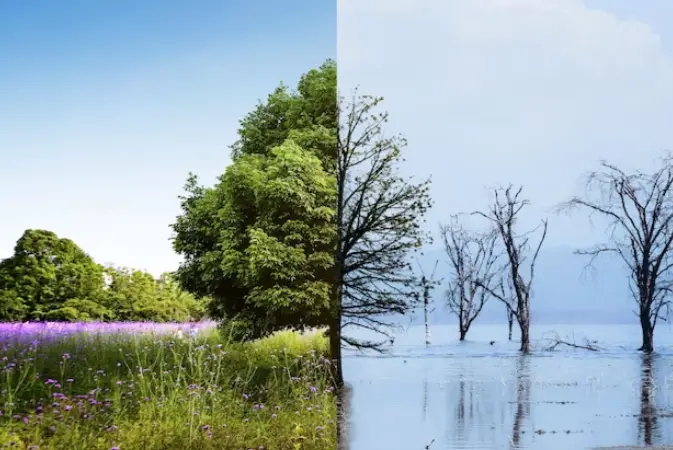Global Warming vs Climate Change: Navigating the Environmental Landscape



In a world increasingly grappling with environmental challenges, the distinction between global warming and climate change often blurs. This article delves into the intricacies of these terms, offering a comprehensive exploration of their meanings, impacts, and the collective efforts required for a sustainable future.
Global warming, a gradual increase in Earth's surface temperature, is intricately linked to the greenhouse effect. This phenomenon, driven by human activities, traps heat in the atmosphere, leading to a rise in average temperatures globally.
While global warming contributes to climate change, the latter encompasses broader shifts in weather patterns, including temperature variations, precipitation, and more. It serves as the overarching umbrella under which global warming operates.
Human activities, such as burning fossil fuels and deforestation, intensify the greenhouse effect. This process involves the trapping of heat by greenhouse gases like carbon dioxide and methane, creating a warming effect on the planet.
The repercussions of global warming extend beyond a mere temperature increase. Extreme weather events, from hurricanes to droughts, become more frequent and intense, challenging our ecosystems and communities.

Climate change encompasses a spectrum of environmental transformations. These include alterations in precipitation patterns, shifts in ecosystems, and disruptions in ocean currents, collectively shaping the world we live in.
Human-induced emissions, primarily from the burning of fossil fuels, contribute significantly to global warming. Recognizing and curbing these activities is crucial for mitigating the adverse effects on our planet.
International efforts, such as the Paris Agreement, signify a collective commitment to address climate change. Collaboration on a global scale is essential for developing and implementing effective strategies.
Rising temperatures and changing ecosystems pose threats to biodiversity. Conservation efforts are paramount to preserving the rich tapestry of life on Earth.
Melting ice caps and glaciers contribute to rising sea levels, endangering coastal communities and ecosystems. Adapting to these changes requires a multifaceted approach.
Mitigating global warming involves a combination of reducing emissions, transitioning to renewable energy, and implementing sustainable practices. These strategies lay the foundation for a more environmentally conscious future.
Transitioning to renewable energy sources, such as solar and wind, is pivotal in mitigating climate change. Embracing these technologies fosters a sustainable energy landscape.
Individual choices, from sustainable living to responsible consumption, collectively contribute to mitigating climate change. Recognizing the power of personal actions is pivotal.
Enterprises play a significant role in shaping environmental outcomes. Corporate responsibility involves adopting sustainable practices and reducing ecological footprints.
Addressing skepticism requires open dialogue, presenting evidence, and emphasizing the consensus within the scientific community. Bridging the gap between differing perspectives is key to collective action.
Climate change profoundly impacts public health. Recognizing the interconnectedness of environmental and human well-being is crucial for comprehensive solutions.
In conclusion, addressing global warming and climate change requires a united front. From individual actions to international collaborations, collective efforts pave the way for a sustainable and resilient future.
Global warming refers to the gradual increase in Earth's surface temperature, primarily driven by human activities and the greenhouse effect. On the other hand, climate change encompasses broader shifts in weather patterns, including temperature variations, precipitation, and more.
Human-induced activities, such as burning fossil fuels and deforestation, contribute significantly to global warming. These activities release greenhouse gases into the atmosphere, trapping heat and leading to a rise in average temperatures.
Individuals can make a difference by adopting sustainable practices, reducing carbon footprints, and supporting initiatives that promote environmental conservation. Small actions, when combined, have a substantial impact.
International agreements, like the Paris Agreement, demonstrate a global commitment to addressing climate change. They provide frameworks for collaborative efforts, emphasizing the importance of collective action on a worldwide scale.
Corporations have a crucial role in shaping environmental outcomes. Corporate responsibility involves adopting sustainable practices, reducing emissions, and promoting eco-friendly initiatives to minimize the environmental impact of industrial activities.
Climate change can have profound effects on public health, including the spread of diseases, heat-related illnesses, and disruptions to food and water supplies. Recognizing the interconnectedness of environmental and human well-being is crucial for comprehensive solutions.
Embracing change for a sustainable future requires a collective commitment to understanding, addressing, and mitigating the impacts of global warming and climate change. From individual choices to global collaborations, each action contributes to the broader tapestry of environmental preservation.